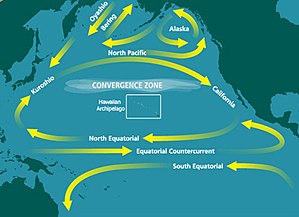The Pacific Trash Vortex: What is it?
 When you picture a vacation, the scene of a white, sandy beach, blue ocean, and palm trees might be the image that pops in to your head especially for you northerners who experience 7 months of winter each year. The tranquility and peace that is associated with oceans and beaches is one that holds true across many societies. Whether it is the mystery that surrounds the ocean (it's animals, coral reefs, and infinite depth) or the warm weather that is sometimes incorrectly assumed, a beach is many people's "happy place"... including mine.
When you picture a vacation, the scene of a white, sandy beach, blue ocean, and palm trees might be the image that pops in to your head especially for you northerners who experience 7 months of winter each year. The tranquility and peace that is associated with oceans and beaches is one that holds true across many societies. Whether it is the mystery that surrounds the ocean (it's animals, coral reefs, and infinite depth) or the warm weather that is sometimes incorrectly assumed, a beach is many people's "happy place"... including mine.
However, there are some parts of the ocean where the beaches aren't clean and white and where the blue water is fragmented with empty bottles and plastic bags: I'm talking about the Pacific Trash Vortex. Also known as The Great Garbage Patch, this area of ocean which is located in the North Pacific Ocean is a home to chemicals, plastic bags, sludge, and other items that humans create and deposit. These pieces of debris get trapped here and in other parts of the ocean due to the circular current. The estimates of the size range from 700,000 kilometers to 15,000,000 kilometers. Items float there and then get stuck created a "pile up". A trash dump inside Mother Nature's womb.
Despite the way it sounds, this not-so-average trash dump is not one that you would boat over and directly identify. Because a large amount of the trash is plastic or contains plastic, it often breaks down in the water and becomes hard to see. This area is identified by measuring the neustonic plastic in the water in certain areas. Not to mention that many of the trash that rests in this area is found beneath the surface of the water and the depth of this area can be thousands of feet deep.
So.... Would you vacation here?
http://en.wikipedia.org/wiki/Great_Pacific_garbage_patch
http://www.greenpeace.org/international/Global/international/planet-2/report/2007/8/plastic_ocean_report.pdf

No comments:
Post a Comment